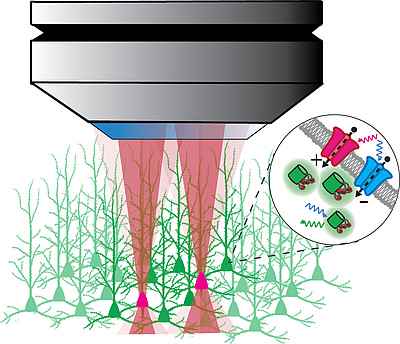Sie befinden sich hier
Inhalt
Date: 25.03.2024

A new technology for all-optical monitoring and manipulation of neuronal circuits, based on 3D holography, will be established at the MCTN. Under the leadership of Prof. Dr. Simon Wiegert, head of the Department of Neurophysiology at the MCTN, an application for an "upright two-photon microscope for intravital fluorescence microscopy and photostimulation" was submitted in August 2023 within the framework of the "Major Research Instrumentation" funding programme (according to Art. 91b of the Basic Law). After review by the German Research Foundation (DFG), the application was approved in February 2024. Now that funding has been secured, the next step for Prof. Wiegert will be to purchase the two-photon microscope. Commissioning of the instrument is planned for the first quarter of 2025 and the two-photon microscope is expected to be ready for use at the Mannheim Medical Faculty in the summer of 2025.
With the continuous improvement and development of genetically encoded fluorescent indicators of neuronal activity for a large number of signalling molecules and metabolites, two-photon microscopy has become an established method for investigating a wide range of biological processes in the life sciences. Due to its high penetration depth in biological tissues and its relatively simple operation, this method is particularly suitable for live imaging in the central nervous system. Applications for two-photon microscopy include fluorescence imaging of fast subcellular processes such as calcium dynamics in neuronal processes or synaptic transmission, calcium imaging of large cell populations, or chronic imaging of cell morphology and motility.
In addition to imaging, two-photon excitation can also be used to stimulate light-sensitive proteins. The innovative combination of multiphoton microscopy and optogenetics allows new, previously inaccessible questions to be answered in neuroscience research. In the longer term, optogenetic interventions hold great promise for the medical treatment of various neuropsychiatric and neurodegenerative diseases. Targeted manipulation of defined groups of neurons could help to restore coordinated network dynamics or the activity of specific cells that have lost functionality. However, the field is still far from establishing optogenetic circuit manipulation as a medical treatment in the clinic, especially in the central nervous system. Therefore, basic research needs to be further developed to gain a deeper and more precise understanding of how brain regions are functionally connected, which neuronal populations are involved in specific behaviours, and how neuronal network dynamics encode and store memories.
"Two-photon microscopy and optogenetics have become indispensable tools in my group's research and are regularly used in combination to achieve our scientific goals." says Prof. Wiegert. "Advances in multiphoton microscopy, with the recent implementation of holographic 3D manipulation of cell ensembles, now allow all-optical circuit manipulation and monitoring with cellular resolution in the brains of living animals."
The upright two-photon microscope for intravital fluorescence imaging and photostimulation will be established in the Live Cell Imaging Mannheim (LIMa) core facility of the Mannheim Medical Faculty and will be available to the research community. The instrument can be used, for example, for long-term monitoring of immune responses to brain tumours, interaction of brain cancer cells with neurons, brain cell dynamics during pathological states such as neuroinflammation, optogenetic investigation of nociceptive and somatosensory peripheral neurons, cardiovascular (patho)physiology and all-optical investigations of cellular networks using optogenetic manipulation and functional read-out of cellular and subcellular function in the brain. The system will allow two-photon imaging of neuronal dynamics in vivo and in slices in conjunction with holographic two-photon stimulation.
The costs of €1,150,000 are jointly funded by the German Research Foundation (DFG) and the Ministry of Science, Research and the Arts of the State of Baden-Württemberg through the Structural and Innovation Fund for Research (SI-BW). The aim of the Structural and Innovation Fund is to support top-level professorships at universities in Baden-Württemberg.
